#Also I think a lot of fantasy media would be cooler if there were conditions that were more innately magical
Explore tagged Tumblr posts
Photo

Octummber '23 - 4
And here's day 4!
Posted using PostyBirb
#art#artist on tumblr#furry art#fatfur#fatfur art#wg sequence#Drawing: Digital#OC: Tereti#So I think I'll probs try to rework a bunch of these sketches I have#I want the poses to be more dynamic#because some of them feel like treading the same ground over and over#Also I think a lot of fantasy media would be cooler if there were conditions that were more innately magical#Which is kinda what I want to do with my sona having 'Glasskin'#and how that's going to stop being a thing through the sequence#furry#scalie#Octummber#Octummber 2023
7 notes
·
View notes
Text
BECAUSE I’M NOT POPULAR, I’LL READ WATAMOTE: CHAPTER #141
The first half of Golden Week is over, and Tomoko has found herself the object of “platonic" affection for four different suitors. And as our intrepid heroine muses over the which of them to pursue, out of nowhere comes the dark horse. Once thought to be missing in action, this little girl, having been there since the very beginning, threatens to overtake the competition in one psychotic swoop.
Chapter 141: Because I’m Not Popular, I’ll Go to School with Kii-chan
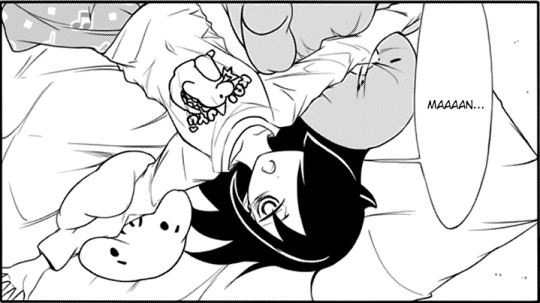
The things that Stuffed Yuu-chan and Pals have seen...
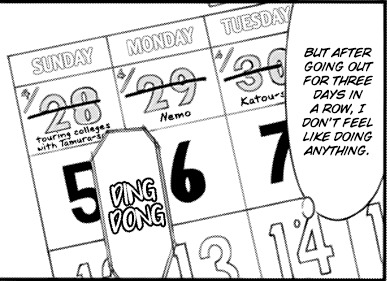
Ah, the classic Introvert Burnout. I had a feeling Tomoko would be drained after having what may have been the most socially stressful time of her life. Not simply for being social, but for how much she had to navigate as a fish out of water. Each “date” involved a new experience for Tomoko to address, and that much effort at once can be really exhausting for a layabout like her.

That my friend is what we in the TvTropes community call, “Tempting Fate”.

Heeeeeere’s Kii-chan!
Can’t even begin to tell you how much I love this entrance. We all know who Kii-chan is. But even those outside of the loop would get a feel for who she is. Adorable and sweet-natured, but disturbing due to an apparent lack of negative emotions (even when appropriate). Ah, Kii-chan, it’s been far too long.

Nothing to say here, really. Just think it’s a particularly lovely picture of Tomoko.

Because the popularity of a manga series is largely dependent on real-time reception, it’s very common for mangakas to add new, “popular” characters, or give the spotlight to characters who’ve been out of focus. Watamote is no exception. It may seem contrived to bring Kii-chan back after being gone for a while, but it works here because it relies on Kii-chan’s character to it, instead of a series of implausible plot developments. Kii-chan is just considerate of her cousin’s schedule–that’s all we need.
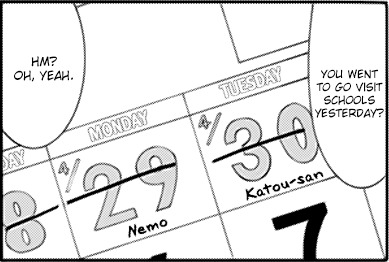
The first hint of Tomoko’s reawakening as the role model onee-chan.

One of the perks of being a sporadically-appearing character is that you can really see just much the art style has evolved since the character’s last appearance. For Kii-chan, she hasn’t really changed much design-wise other than being a little taller. But even then, the linework is much cleaner and consistent this time around, which compliments the more “everyday slice-of-life” approach Watamote’s been embracing.
If only she could grow a nose.
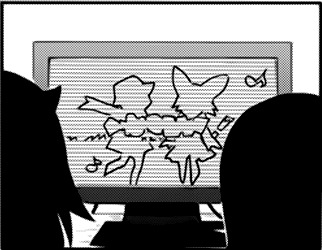
The best thing about this type of censorship is that you don’t necessarily have to understand what's being censored. All you really need is a bit of context to put the pieces together. The outlines are detailed enough that we can see the characters as some kind of humanoids with animal features. And given what we know about Kii-chan, it makes perfect sense.
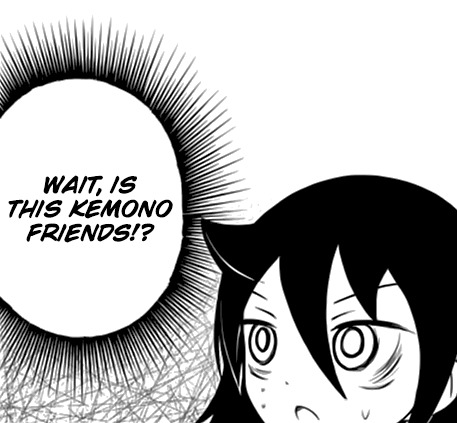
Y-Yeah, I...I’ve totally heard of that show.
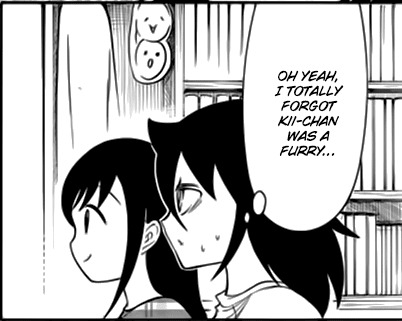
Other than the whole Ucchi situation (which is slowly becoming an unintentional blessing), this is the last of the misunderstandings that still needs resolving. It’ll be hard, though, since this particular issue isn’t that troublesome. For now...

Look at that platonic sibling bonding.
Perhaps I’ve been conditioned by manga/anime, but I find it refreshing how Watamote has managed to develop the Kuroki siblings’ relationship while avoiding any incestual subtext. Lots of series oversell the sibling relationship by having them be overly affectionate and clingy. With Watamote, their bond feels organic because they don’t have to be touchy-feely. An unspoken quality time is all there is to it.
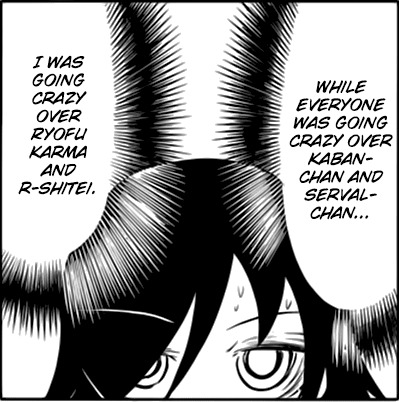
It’s hard to get a read on Tomoko’s emotions here, but at the very least, she seems troubled. It could very well be that Tomoko just realized that she’s changing in regards to the media she consumes. The former her would’ve probably jumped on the Kemono Friends bandwagon, but the reality is, Tomoko’s otaku interests are being compromised by the mainstream, at least as mainstream as rap battles get.
But the kicker is...she realizes this change isn’t all that bad.

Of course, nothing beats watching anime with your psychotic cousin.
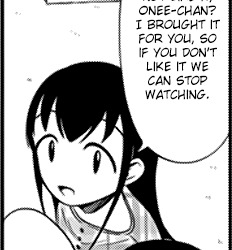
The whole “pet-sitting” relationship they have here is a tricky one since each side is trying to accommodate the other based on “flaws” that don’t exist (or no longer exist). This usually results in an endless cycle of misunderstandings that lead to nowhere, but this confusion has transcended that cycle to develop into a progression of sorts. Similar to the Ucchi situation, the absurdity became so frequent that it just became reality. One that each side has been influenced greatly from.
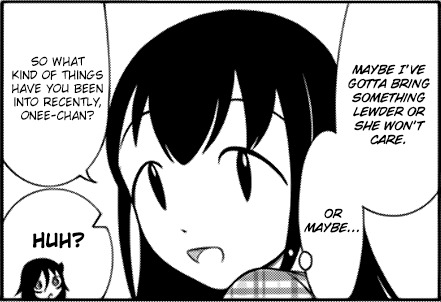
With her constantly adorable face, you forget that Kii-chan is a middle-schooler and is therefore old enough to know about things like sex and perversion. Like Yuu-chan, she may look innocent, and while she was aware of such things as a kid, she didn’t really get it until they approached high-school age.

You know, I read this really good manga called Kaguya-sama: Love is War (shameless plug, I know), and they actually had a chapter about a rap battle a while back. Given that both series tend to be up-to-date on contemporary trends, it makes me wonder...has rap suddenly become a hot thing in Japan? Or has it always had its niche audience?
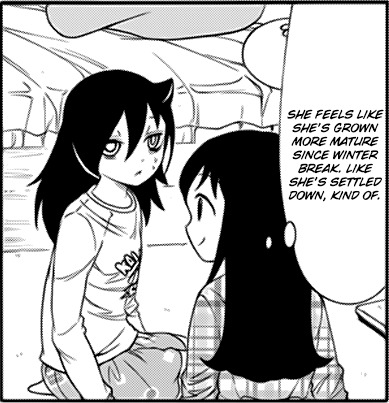
I’m sure many fans knew that this was going to be an inevitable development whenever Kii-chan showed up again. Unlike Tomoko’s school friends, Kii-chan wasn’t there to see the slow, gradual growth of Tomoko’s character, so it must have hit her like a ton of bricks to see her precious onee-chan go from helpless loner to mature teen in the blink of an eye.
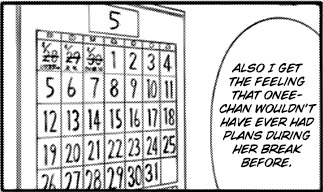
Sometimes I wonder just how pitiful Kii-chan thought Tomoko really was...
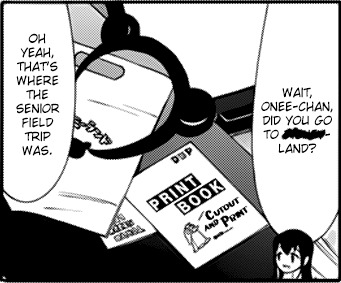
Why would you censor Disneyland now of all times?

Those of us who were clamoring to get close-ups of the photos taken in the Disneyland arc finally get their wish.
The Kowarith photo is my favorite, even though two-thirds of the people in it are faking their asses off. While that may be my personal bias towards the Tomoko-Yoshida-Yuri trio, I think it reflects a better sense of kinship between the girls. The effort is there, phony as it is, to support each other in an awkward situation, which is fundamentally what the series is all about.
The assumedly Fireworks photo is also pleasing, make no mistake. You can definitely feel more genuine emotions (or lack thereof) being expressed than in the other photo. But this focuses more on the individual than how they work as a collective group, despite there being more people. The girls ultimately look like six different colored Skittles–part of the same package, but each unique.

Could this be the start of Kii-chan revitalizing her perception of Tomoko as a super popular girl? I sure hope so.

How ironic. Kii-chan’s perspective of Tomoko is starting to grow ever so gradually on the upside, whereas Tomoko’s perspective of Kii-chan grows more and more negative.
Hang on, is that supposed to be some fake Dragonite shirt? Neat.

At this point, people assuming that Yoshida as some kind of punk based on her looks is a dead horse of an issue. Some stereotypes exist for a reason, I suppose.

I see your game, Nico Tanigawa, using a deliberately vague line about “two girls” to make your readers overanalyze a single panel. All I have to say to that is that I am completely and utterly guilty.
One of the girls is probably Yuri, if only because she’s the only girl to appear in both photos. As for the second girl, your guess is as good as mine. I’m inclined to say Ucchi because if Kii-chan only has their appearances to go on, then Ucchi and her emoji-face make quite the impression.
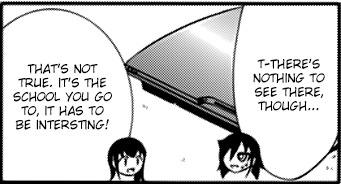
I’m getting Yuu-chan vibes here with the way Kii-chan phrases half-insults with a friendly demeanor.
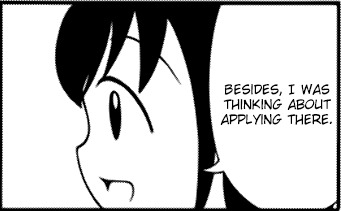
+ 1 TO THE HAREM.
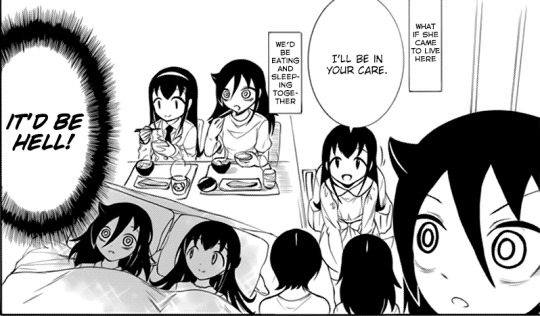
Kii-chan is definitely that relative you leave a self-imposed boundary on. Fine in small doses, like at parties and family gatherings, but long-term exposure is unhealthy for the brain. This isn’t even a wholly exaggerated fantasy on Tomoko’s part. Okay, the eating bit is a little much, but given that Kii-chan allegedly dreams about treating Tomoko like a pet, the latter is right to be a little concerned.

There needs to be an AU one-shot of Tomoko, Tomoki, and Kii all going to the same school at the same time. Right. Now.

I do appreciate that despite Kii-chan’s deteriorating sanity, Tomoko doesn’t view her as a lost cause and even tries to put a positive spin on it. Reconciliation Arc is a-go!
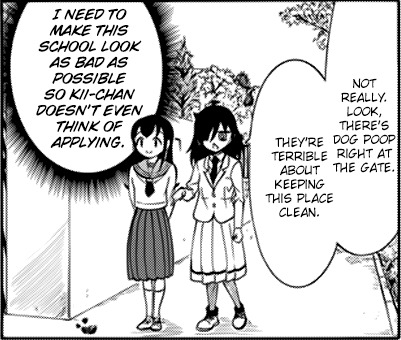
Did Kii-chan really have that big of a growth spurt, or has Tomoko just reached her peak in height? Not sure how far the genetics will go, but Kii-chan becoming taller than Tomoko is only going to make her even more intimidating.
This little scheme of hers is definitely reflective of the “old” Tomoko, but there’s a nice reversal going on here. Instead of Tomoko trying to make things sound cooler than they actually are, she’s trying to make things seem worse. Of course, Murphy’s Tomoko’s Law states that anything that can go wrong, will go wrong. Especially if Tomoko wants it to go right.

Ah, Ogino. The only character whose relationship with Tomoko has remained relatively unchanged despite indirectly having the most impact on Tomoko’s life.

Better update her Wiki page now.
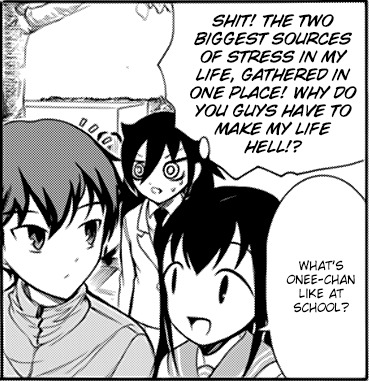
It’s pretty telling how it’s these two who cause Tomoko the most grief. It’s not the delinquent who routinely bashes her face in, not the pervert(s) lusting after her little brother, and not the otaku who passive-aggressively teases her. As for why, I think it boils down to the fact that Ogino and Kii-chan challenge her comfort zone the most. It also doesn’t help that Tomoko doesn’t interact with them as often as the others, so she hasn’t really had the time to get desensitized by them.

This freakin’ teacher, man.

The second worst part of Ogino’s “help” is that she never actually lies. Sure, she exaggerates to hell and back, but it’s always loosely based in reality, like some cheap movie adaptation of a best-selling novel.
But the worst part of it is...you can’t hate Ogino for it. Her personal assessment may be founded on largely suspect reasons, but it’s still an honest assessment. I have no doubts that Ogino really is proud of Tomoko, and that’s exactly why she’s the best worst teacher.
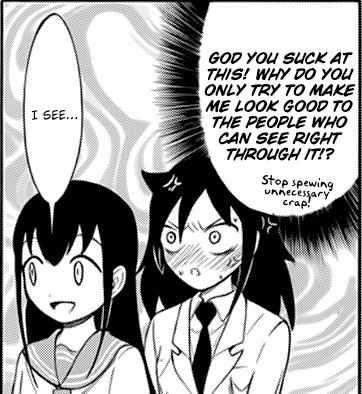
That’s true. If Ogino gave that spiel to people like Hijirisawa or Hatsushiba–y’know, people who don’t know her as well–they might actually buy that crap. But people who know Tomoko like Yuri or Nemo, people like us, can tell that Ogino’s sugarcoating the whole thing. Kii-chan, with her terrifying skill for knowing too much, is no exception.
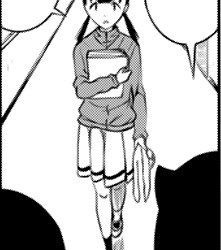
Ah, I see. This is one of those put-all-the-secondary-characters-who-we-haven’t-seen-in-a-while-into-one-chapter chapters.
Can’t complain, though. I like Itou.

“Or something” can also be translated as “lust after Tomoki”.
We don’t really have much to go on for how Itou views Tomoko, but I think it’s reasonable to think that she may not see her in that good of a light. Not only did Tomoko give off a weird impression when she played off the whole fist bump thing, but Itou’s “powers of perception” probably made her aware of Tomoko and Komiyama’s frenemy-ship, hence her “warning” that Komiyama was around.

The Inherent Awkwardness of Second-hand Relationships: The Life of Tomoko.
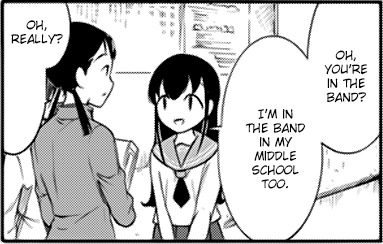
Betcha’ no one saw this interaction coming. Whether it’ll lead to anything more remains to be seen. Itou’s still got the whole “friendship potential” going on with Futaki, but given that she has the tolerance to BFF Komiyama, I see no reason why she can’t befriend a psycho like Kii-chan.

That desire to “loudly blow” is Kii-chan’s inner demons screeching out in desperation for release. I pity the fool who unleashes the beast.
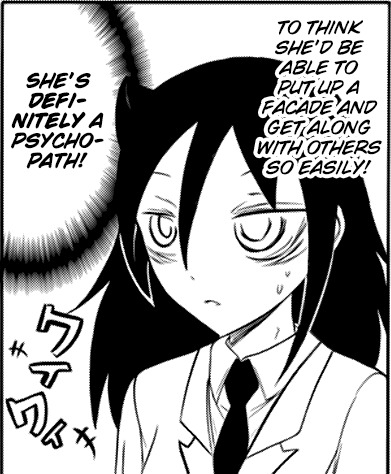
That does sound like your typical amateur definition of a psychopath, doesn’t it?
For the record, I don’t actually believe Kii-chan is a psychopath, despite the jokes I made. There are way too many moments that discredit such a claim. Now, if you were to accuse Kii-chan as being some sort of deviant (sexual or otherwise) I might see that. But ultimately, I think Kii-chan was just a victim of having her innocence shattered too fast and too soon, which made her more, uh, crafty than Tomoko could handle.

Man, it’s been a long time while since we last saw Dicky-chan, hasn’t it? Hope we get to see more of her (and Sayaka, for that matter) after this chapter.
I love how even when she’s collecting masturbation material, Komiyama has to hold her camera phone all lady-like. If the term “purevert” ever needed a concrete definition, this girl would be it.
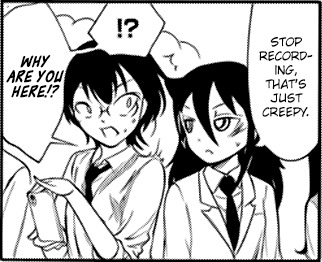
Main Character privileges, that’s why.

Get. The. FUCK. Out. Of. Here.
With each subsequent appearance, Komiyama’s standard for what constitutes a bitch primed to steal away her Tomoki-kun falls hilariously lower. It’s not enough that a girl in their class makes two seconds of eye contact with him, nosiree. Any girl with an inkling of a relationship with Tomoko is not immune, even if it’s his own damn cousin. Granted, I don’t think Komiyama would be so pathetically scummy as to confront Kii-chan about it like she did to Yoshida.
...I hope.

“Best friends” may be stretching it now that we’ve gotten this far in the series. However, there is one aspect of Tomoko and Komiyama’s relationship that triumphs over all the others:
Absolute candidness. Even now, the only one who gets to see the complete, raw package that is Tomoko Kuroki is Komi-something. While Tomoko has made substantial friendships with the likes of Yuri, Nemo, and Katou, Tomoko still restrains herself just a tad lest she pushes them away. It’s only with Komi that Tomoko bears her full ugliness, which I think has developed into some freakish level of respect/understanding that none of the others can claim.

Damn, even the bishounen dude gets to make an appearance. All we need know is Lethal Chef Girl to make a cameo and I’m set.

Nope. Any game is an away game when your “harem” shows up to cheer you on.
A few people have expressed discontent with how the chapter seems to end so abruptly, and it’s a fair criticism. It may be the lack of a “Next time...” tagline throwing people off, but while this chapter indeed ends at an odd point, it’s not that unprecedented. Some of the previous chapters ended this way, like that time Komi was all “Oi!” at Yoshida at the cafeteria, which indicates that this chapter is likely one of those series-of-vignettes that also doubles as a build-up chapter.
On a positive note, while the chapter does feel prematurely ended, how the next chapter plays out if it is connected to this one is sure to be a surprise.
#watamote#watamote review#chapter 141#no matter how i look at it it's you guys' fault i'm not popular!#tomoko kuroki#kiko satozaki#ogino#itou#kotomi komiyama#akari iguchi#tomoki kuroki#that one bishounen dude#review
29 notes
·
View notes
Text
Gaza
A news story appeared briefly last week in the press and then vanished. It wasn’t much of a story, just a vignette really, but it has stayed with me ever since and feels, at least to me, as though it encapsulates the intractable nature of the conflict between Israel and the Palestinians of Gaza. And yet…somewhere within its scant details I also see a bit of light, perhaps even some reasonable hope.
The story concerned two eight-year-old boys who somehow managed to slip across the border into Israel armed with a single knife between the two of them. They were apprehended and almost immediately, disarmed, then sent back across the border into Gaza. That’s the whole story.

When asked what they had been hoping to accomplish, the boys explained that the plan was to be arrested and eventually sent to an Israeli prison. Left unexplained was why exactly they wanted that to be their fate. The media reports I read seemed to assume that the point was for the boys were baby terrorists hoping to become famous by murdering a civilian Israeli and then bravely by enduring life in an Israeli prison no matter how harsh the conditions. But it feels—to me, at least—at least possible that the idea was something else entirely and that the boys were attempting to get out of Gaza the only way they could think of—by getting themselves arrested and sent to an Israeli prison where they knew (or at least hoped) that children would be treated leniently and perhaps even kindly. Where there would be clean water, fresh food, and medical care. Where they might even just possibly have a school for underage inmates to attend.
So that’s my fantasy, developed within my own ever-hopeful brain as the protests at the Gaza-Israel border started up again on the one-year anniversary of their original outbreak. Over 40,000 Palestinians showed up for the anniversary rally, but the scene was really quite different from what we saw at the border a year ago. Within an hour, half the protesters had gone home. An hour after that, there were just a handful of stragglers left. The whole thing had a largely pro forma feel to it. Yes, some people did throw grenades or Molotov cocktails in the direction of the fence along the border, but the large majority of people who showed up for the protest stayed away from the border and did not risk provoking the inevitable Israeli response to any effort to cross the border illegally. The Health Ministry in Gaza, run by Hamas, claimed that two people, both teenaged boys, were killed during the protest and that hundreds were wounded. (They didn’t say by whom, but the clear implication was that Israeli soldiers had shot, yet again, at innocent protesters.) More to the amazing point was the presence, visible to all, of Hamas officials wearing day-glo orange vests stationed between the crowds and the border, and almost entirely effectively preventing anyone from rushing the fence or trying to cross into Israel. This was, by all accounts, something entirely new.
Partially, the credit goes to Egypt’s efforts to mediate a peaceful modus vivendi on the Gaza border. And another part surely goes to the IDF, which, by deploying a large number of soldiers at the border and providing them with serious support from the air, indicated clearly that it was going to do whatever it was going to take to prevent Gazans from crossing the border into Israel and harming Israeli civilians. But there is also the possibility that the Gazans themselves are growing weary of this endless battle with Israel and are yearning for the kind of normalcy that can only be a function of peaceful co-existence with Israel.
Supporters of Israel, and myself among them, never grow tired of pointing out that the residents of Gaza formally elected a Hamas-run government to lead them in 2007 and so must now bear the consequences of having terrorists for their political leaders. (There are no plans for any sort of new elections, the general disinclination of terrorists to cede power peacefully to others being one of the negative side-effects of installing a government led by terrorists in the first place.) The seemingly endless barrage of missiles aimed at civilian centers in Israel, the government’s willing to squander countless millions of dollars of aid money—by some estimates $40 million annually (click here for more on that sum)—to build the so-called “terror tunnels” whose sole function is to allow terrorists to cross unobserved into Israel, and the intensive indoctrination of Gazan children to think of Israelis as monsters and oppressors rather than nearby neighbors yearning to find a way to co-exist peacefully with the neighbors (which is the attitude of more or less every single Israeli I know personally or have ever known)—all of this makes most Israelis and supporters of Israel despair of there ever being any sort of resolution to the conflict.
It’s a small place, Gaza. The border with Israel is only thirty-two miles long. The border with Egypt is not even seven miles long. The whole place is a mere 141 square miles. (By way of comparison, Nassau County occupies 453 square miles of Long Island.) But 1.8 million people live there, which yields the figure of more than 13,000 residents per square mile. (Nassau County has fewer than 3,000 people per square mile.) So that’s a lot of people in just a very little space. Since throwing in their lots with Hamas, the Gazans have been under an Egyptian and Israeli blockade designed to prevent the smuggling of weapons into Gaza. That certainly sounds reasonable to me given Hamas’s openly proclaimed policy never to co-exist peacefully with Israel and their willingness to use the weaponry available to them to attack civilian Israelis inside Israel. But it also means the Gazans, for all they have the government they elected in place, are even less the masters of their own fate than they were before Israeli withdrew unilaterally in 2005 and inadvertently created the vacuum that Hamas was invited by the populace to fill.
And so we can frame this as a tale of two sets of two boys: the two seventeen-year-olds killed in the tumult at the border the other day as part of a pointless riot that had absolutely no chance to effect anything like meaningful change (and which merely put tens of thousands of people in harm’s way), and the two eight-year-olds armed with a single knife who somehow managed to enter Israel and whose plan was possibly—at least in my own fantasy version of the story—to be arrested and sent to a prison that would presumably feature at least some of the trappings of normal life. The teenagers killed at the border symbolize to me the pointlessness of violence and the dismal prognosis for Gazan residents if they prove unable to turn away from Hamas and embrace leaders eager and willing to live in peace with Israel. The little boys apprehended in Israel, on the other hand, represent some strange combination of daring and willingness to look across the border and see, not monsters or murderers, but young men fully human who only want to go home safely to their families and to live in peace. Obviously, I don’t know these little boys. I don’t even know their names. (Because of their age, their names were not released to the public.) But I’d like to think that they represent the Gazan version of the boy in Hans Christian Anderson’s story, “The Emperor’s New Clothes,” the one who saw what his eyes actually did see rather than what the grown-ups all around told him constantly told him he was seeing.
I was in Israel in 2005 during the Gaza withdrawal. There were people everywhere wearing orange ribbons to indicate their ill ease with the notion of withdrawing from Gaza other than as part of a larger peace deal with the Palestinians. And some of the televised scenes we all witnessed of Jewish people being forcibly removed from their homes were wrenching to watch…and that was a sentiment shared by all regardless of political persuasion or affiliation. But, in the end, it was what Ariel Sharon wanted. The Knesset approved the plan in February of 2005. And before Rosh Hashanah it was all over and there was not a single Israeli in Gaza. It was a stunning act of hope on the part of Israel, a unilateral leap into an unknown future justified by the feeling that it could conceivably lead to Gazans taking charge of their own future and turning away from violence and towards peace. Within two years, Hamas was firmly in charge. And now, a dozen years later, the situation feels just as dismal as it did following the Hamas electoral victory in 2007. But hope is a funny thing—it becomes dormant but it never quite dies…and I continue to hope that cooler heads will eventually prevail, that Hamas itself will realize how much money it has wasted and how many lives the mindless violence it promotes has cost the Palestinian people with no appreciable gain at all, and that the people of Gaza themselves will follow the example of two little boys by looking into Israel and seeing not a hellish landscape populated by ogres and fiends, but a land flowing with milk and honey populated by people eager and willing to do what it takes to live in peace.
0 notes
Text
You Will *Learn* Patience (Tasting The 2016 Port Vintage)
I recently received the kind of media invite that one doesn’t turn down, unless one doesn’t have a choice: join a bunch of wine peeps in NYC to taste through a preview of the new 2016 Port vintage, led by representatives from several of the major Port houses. Uhm… yeah, we are definitely going to that. We also tasted some quite older vintages of Port, about which I plan to tell you later, in the hopes that – like all good Port lovers – you can learnt o exercise a wee bit of patience. Also, I’m kind of a dick sometimes.
Regarding the 2016 vintage in Porto: after a seemingly endless string of vintage Port declarations in the 2000s, 2016 marks the first time in a handful of years (since 2011) that a vintage there was deemed worthy enough for a vintage to be declared. The theme, as you will see from my tasting notes of about fifteen (!) of the upcoming releases, is a sense of balance, in which both power and finesse are on display. The vintage was marked by a wet Spring, which was actually needed due to drought conditions from 2015, followed by a hot Summer. The result was a year marked by low yields; in other words, allocations are gonna be tight.
To get a deeper sense of the 2016 vintage, I also include for your listening enjoyment a brief interview that I did with Rupert Symington (part of the family that makes/owns revered Port brands Graham’s, Cockburn’s, Dow’s, Warre’s, and Quinta do Vesúvio), who gave me his thoughts on the first Port vintage in five-or-so years, why we mere mortals need to be both patient and maybe even a little selfless when it comes to buying a wine that takes decades to fully develop, and what he imbibes when he’s not drinking Port.
http://www.1winedude.com/wp-content/uploads/rec_20180508_Rupert_Symington_edited.mp3
It’ll make for decent listening as you peruse the (rather longish) list of my foray into 2016 Port land…
2016 Taylor Fladgate Vintage Port
Rockin’ it since 1692, and over 300 years later, this vintage TF is, indeed, rockin’ it. Pure, black fruitiness abounds (of the raspberry and plum varieties), and there are plenty of herbal and floral notes on the nose. But the great thing about this wine is that it’s like a masterclass in tension; violets and firm tannic grip, heat and freshness (though in this huge wine, the heat has a slight lead).
2016 Fonseca Vintage Port
A very Big Boy of the vintage, even by Port standards, and actually even by Fonseca standards, and they’ve never really been ones to shy away from opulence and power when it comes to their VPs. If drier fruits and mints/herbs/flowers are your thing, then this is your 2016 Port, my friend. The palate gets very Fonseca, very quickly; jammy, tight, structured, and packing a serious punch.
2016 Croft Vintage Port
Croft is technically the oldest Port house (dating back to 1588), and their 2016 shows a but of characterful rusticity on the edges of a supple palate, which kind of conjures up images of traditional foot treading (which, in this case, is actually used). Herbal and rosy to start, then showing ample grip, heat, and black licorice tones, there’s a sense of showiness in the pungent, expressive strawberry and cassis fruit and its long, hot finish. Fascinatingly old School, with a bit of a modern twist.
2016 W & J Graham’s Vintage Port
Plums, dipped in dark, mint-flavored liquid chocolate… it really is that kind of rich. Despite that richness, the structure underneath is focused, precise, even. And the violets and smoky spice and mineral action? Too good not to love. It’s like being able to drink the performance of a thoroughbred.
2016 W & J Graham’s ‘The Stone Terraces’ Vintage Port
If I could distill the tasting notes for Graham’s third Stone Terraces release (hailing from the predominantly south-facing Quinta dos Malvedos), it’d probably end up being “numinous.” Abundantly fruity, powerful, silky, there are hints of how incredibly it will age among its burly, fresh, dense, dark profile. Above that dark tumult, minerality, blossom, and even citrus notes are all dancing some kind of lovely aromatic ballet. Stunning.
2016 Dow’s Vintage Port
Here, we have a rare working combination of massive concentration and elegant poise, from a combination of the riverside houses QUinta do Bomfim and QUinta da Senhora da Ribeira. Mineral, spicy, serious, brooding, dark of blue and black (fresh and dried) fruits, and offering up tobacco leaf and lavender, too. Gorgeously fruity, amped-up, and yet so impressively balanced that it embodies pretty much every cigar room, monocle-wearing fantasy that you’ve ever had (or maybe that was just me that had those?).
2016 Warre’s Vintage Port
Warre’s has the luxury of pulling fruit from the differing climes of the Douro Superior, and Pinhão and Rio Torto valleys. That gives their 2016 a beguiling amalgam of ripe plums/berry flavors, minty tea leaf and anise tinges, and great lift that accentuates the floral and spice notes despite the dark, chocolaty, grippy structure. A long, very dry finish caps it all off. It’s a fascinating, exceptional ride from start to finish.
2016 Cockburn’s Vintage Port
These guys have some of the hottest vineyards in the Douro, and so the powerful ripeness and drier fruit flavors (and tannins to match) ought to be expected. What you might not expect, however, is the clove spiciness (ok, actually maybe you should expect that), the purity of its dark fruit (on second thought… yeah, that, too) and its great acidic lift (ok, that one could have been a genuine surprise).
2016 Smith Woodhouse Vintage Port
This is really, really ripe. It’s also really, really peppery, well-integrated, fresh, powerful, and floral (think roses and tea). In other words, it’s also really, really f*cking good. It might also be one of the most substantial and weighty of the 2016s, so bring your big boy pants for this one.
2016 Quinta do Vesúvio Single Quinta Vintage Port
If history is any guide, Vesúvio’s 2016 will deliver some of the best bang-for-the-Port buck that you can get from this vintage. They are consistently excellent now, favoring foot treading of their upper Douro Superior fruit. Notes of resin and lavender, liquer, mineral, and dark blue and black fruits kick things off here. The palate is velvety, the finish boisterous and extraordinarily long and pure, with a spicy exit. It’s close to what I imagine doing a shot of “purity” would be like, if existential concepts were available in by-the-drink form at the bar.
2016 Quinta do Vesúvio ‘Capela’ Vintage Porto
This is only the third Capela release for Vesúvio, which takes much of its fruit from 90+ year-old vines in the Vinha da Capela vineyard, with some Sousão and Alicante BOuschet from the Vinha da Escola vineyard. And holy spicy, perfumed awesomeness, Batman! The nose here, even in its youth, is simply fantastic: chocolate, rose, mint, lavender, violets, and… peppery AF. Plummy, and big, but also exciting, fresh, and a delight.
2016 Quinta de Roriz Vintage Port
Roriz’s vineyards are between Pinhão and Tua, on the south bank of the Douro River and are mostly northward-facing. The result is a cooler climate (in Port terms), and their 2016 evidences that cooling influence with more noticeable (though certainly dense) red fruits, notes of bramble, and plenty of mint. The palate is mineral, the tannins drying, and the whole thing is a mini wonder in terms of texture.
2016 Quinta do Noval Vintage Port
Raisins, spiced plums, licorice, dried herbs, black fruits, violets… typically complex stuff, for which we Port nerds have come to know and love Noval. The 2016 starts out tighter than a bull’s ass during fly season, but unfolds into layers of blue fruits, spices, pepper, and stony minerals. Rich, fresh, elegant, and flaunting all of it.
2016 Quinta do Noval Nacional Vintage Port
170 cases of this rare and rarefied Port were made, from ungrafted vines that are, in their words, “attached to the soil of the nation.” The vineyard plot, planted to various indigenous Port varieties, is co-fermented, and foot trodden in small lagares, and actually everything about the winemaking here is small in size, like small quantities, from vines that give small (and intense) berries. There’s nothing small about the tannins here, though, or the finish (which is long AF), or the freshness (off the charts for Port), or the complexity of the palate (spicy, supple, grippy, and superb), or the intensity of the nose (schist, pepper, eucalyptus, tobacco leaf, blackberry, plums, and flowers). The words “holy f*ck” appeared in my tasting notes, as used to describe the layers of fruit/spice/texture/tannin and their joyful, dancing interplay; it’s nearly a perfect vintage Port.
2016 Quinta da Romaneira Vintage Port
At the time of the first comprehensive classification of Port vineyards in 1757, Quinta da Romaneira was already tending vines. Their VP is primarily a selection of their older Touriga Nacional and Touriga Franca plantings. While I wasn’t crazy about the finish, this might be the most mineral and also one of the most aromatically compelling of the 2016 VPs that I tasted. It’s powerful, dark, and floral, with cassis, raisin, roses, spices, herbs (and lots of those), and bramble, all anchored with focus and structural tension between freshness and richness. I wager that it’ll be gorgeous drinking in, oh, about twenty years or so…
Cheers!
Grab The 1WineDude.com Tasting Guide and start getting more out of every glass of wine today!
Shop Wine Products at Amazon.com
Copyright © 2016. Originally at You Will *Learn* Patience (Tasting The 2016 Port Vintage) from 1WineDude.com – for personal, non-commercial use only. Cheers!
Source: http://www.1winedude.com/you-will-learn-patience-tasting-the-2016-port-vintage/
0 notes
Text
14 Behind-the-Scenes Secrets of Hollywood Food Stylists
Visit Now - http://zeroviral.com/14-behind-the-scenes-secrets-of-hollywood-food-stylists/
14 Behind-the-Scenes Secrets of Hollywood Food Stylists
Hollywood food stylists are little short of magicians—only instead of pulling rabbits out of hats, they’re turning piles of mashed potatoes into ice cream sundaes. Indeed, making food (or food-like products) appear photogenic and appetizing onscreen is a job for a true illusionist. Mental Floss spoke to a few food stylists working in TV, film, and commercials—from Game of Thrones to Taco Bell—to bring you the tricks of their magical trade.
1. MOST OF THE FOOD BEING FILMED IS REAL.
While food stylists are well-versed in the old-school swap tricks—using a pint of white glue to impersonate a glass of milk, for example—those are being phased out. Now, directors want actors to interact with their food, and high-definition camera lenses have made the fake stuff much more obvious. Plastic food props only appear in the background of scenes today, where they’re less visible and susceptible to scrutiny.
“I only deal with real food,” says Chris Oliver, who has styled food for movies including Gone Girl (2014) and TV shows such as Seinfeld and Big Little Lies. “You also have to think about how a character would cook something or put a plate together. Realistic food is not all beautiful and perfect. I make ugly food and burnt food, too.”
There’s a trend in commercial food styling to present dishes that are less-than-perfect, too. Shellie Anderson, who styles food ads for clients including Burger King and Ragù, says it’s the consumers who are demanding food look more realistic and therefore more approachable.
“People are tired of seeing something in a TV commercial and then ordering it in a restaurant and it doesn’t look the same,” she says. “You don’t want it to look staged anymore. You want a burger to look like the cheese naturally dripped off and landed on the plate.”
2. THEY GO THROUGH A LOT OF FOOD …
If a food stylist needs one sprig of parsley for a shoot, they’ll often order 10 bunches. They never know what the condition of the parsley is going to be when it arrives from the produce vendor, or if the shoot is going to require more than they originally planned for. Carving a turkey in a scene? That may require two dozen birds if an actor keeps flubbing his line.
“It really depends on how much of a story point the food is and how important the scene is for the director,” Oliver says.
Food stylists usually have relationships with produce vendors, who can look for products with the specific size, shape, and color that stylists need. No bruises or dents, and no frozen lettuce! But stylists can hide those things if they have to.
Ice cream is infamously hard to keep intact because it melts so quickly. Food stylists have been known to replace the scoops with dollops of meringue, which don’t melt, or butter rolled in sugar. Oliver makes her sundaes the day before and sticks them in the freezer, spoons and straws and all. If they freeze rock hard overnight, they can last a few hours on set the next day before being replaced with another sundae lined up in the deep-freeze. Anderson sprays her ice cream with cold spray, an aerosol can of super-chilled gas used for cooling electronics.
3. … BUT THE FOOD RARELY GOES TO WASTE.
On film and TV shoots, there are rarely leftovers. In fact, good food stylists often compete with the caterers: Actors usually have to eat the food during their scenes, and the crew finishes off the scraps. While shooting a Chinese New Year scene for the show Fresh Off the Boat recently, actress Lucille Soong told Oliver, who was styling that episode, that she was going to skip lunch because she wanted to enjoy eating her food on camera. “That was pretty freaking flattering!” Oliver says.
Because Oliver works on multiple TV shows in a single day, if an item doesn’t get used on set and never comes out of her cooler, she can just take it back to her shop and recycle it for use on another show. If something can’t be used again, she’ll take it home and make salsa or jam. “When it gets really old, I’ll just stick it in vodka,” she says.
Commercial shoots tend to have more unused food. Anderson says anything that’s still edible will be given to a food pantry. “I once donated an entire swordfish when we did a commercial for a fish restaurant,” she says. “We never even used it. So I kept it on ice and took it to a men’s homeless shelter. They were thrilled to have it.”
4. THEY VALUE FOOD SAFETY.
Another reason food stylists swap out on-camera food so much is because of safety concerns—hot and cold foods need to be kept at certain temperatures that may not be practical on-set. Sushi-grade tuna may be replaced with watermelon, for example, because the fish spoils so easily.
Oliver requires all of her employees to have a food handler’s license. She also only works out of commercial kitchens (including the one on her fully-equipped food styling truck). But not every food styling team does; some prepare food in their homes. “The reason that I get so much work is that everybody knows I’m a chef and I have a real kitchen,” Oliver says. “People trust my food. I’ve done a bunch of movies with Reese [Witherspoon] because she knows that if I’m on set, the food is safe to eat.”
5. WOMEN DOMINATE THE FIELD.
While there are a few well-known male food stylists, for the most part the key food stylists in the U.S. are women. (Both of Anderson’s daughters are food stylists, too.) The reason for this dates back decades.
Before food styling became its own career in the 1990s, it was up to network employees with home economics degrees (almost always women) to cook on-camera food. Then props departments became responsible. “But props guys can’t even make spaghetti,” Oliver says, laughing. So according to her, these guys would go home and ask their girlfriends or wives to make whatever food was required for the next day’s scene. “Eventually they would just hire their girlfriends or wives to do it; keep the money in the family,” she says. “I know five food stylists who at one time were in relationships with prop masters.”
Also in the 1990s, networks began making more multi-camera TV shows. A lot more food began appearing on screen, and actors openly discussed their dietary restrictions. They were vegan, sugar-free, and low-carb all of a sudden. Oliver trained at the Culinary Institute of America and had worked in restaurants and catering jobs before stumbling into this career. “Because I was a chef, and I understood how food works, I knew how to feed people and make food last on set,” she says. “And I could charge anything I wanted to.”
To get a job as a food stylist today, it helps to know someone already in the industry and have a culinary background. Everyone starts as an intern, and then may be able to work their way up to being an assistant and then a stylist. “Not everybody can be a food stylist,” Anderson says. “You have to be able to cook, but you still have to be creative. And you have to be able to work fast and under pressure.”
6. THEY LIVE OUTSIDE OF LOS ANGELES NOW.
Now that movies and TV shows are frequently filmed all over the world, instead of just on sets in Los Angeles, food stylists can be based anywhere. There is a concentration of stylists who live in Vancouver, British Columbia, for example, because that’s where many shows are now filmed. Labor laws also often require production crews to hire locally, so residing outside of L.A. can be a real advantage.
Some commercial food stylists, like Anderson, are flown in for shoots. “Food stylists can make or break a commercial,” she says. “And if you have trouble and you don’t know what you’re doing, it can be a real problem for production.” This is especially true on out-of-the-country shoots, when stylists don’t have the resources that they’re used to. So clients who know her and her skill level, such as Taco Bell, will fly her to wherever they’re filming.
7. THEY TALK LIKE CHEFS AND FILMMAKERS.
Food stylists use a mix of back-of-the-house kitchen lingo and film jargon. Some examples: The “hero” is the food that is written into the script, is being shot, and must appear in front of the actor. “Bite and smile” is when an actor takes a bite of food and pretends to like it. “All day” is the total number of items needed; if they needed five turkeys on a set, they would say “five all day.”
8. NOT EVERYONE WANTS TO BE IN THE MOVIES.
Food stylists usually specialize in different media: film, TV, commercials, or print editorial. Stylists often prefer one over the other. Print editorial is shot in a controlled studio and tends to have more leeway for creativity. Commercials are tied to a brand’s specifications. Film and TV shoots on location are in unpredictable settings and can be physically demanding. But everyone tends to work long, 12- to 14-hour days. For commercials, it can often take three days to shoot one 30-second spot.
When working on a movie or TV show, the actors’ demands usually take precedence over the food needs. After working on one film, Anderson had had enough and dedicated herself to commercial work. “When I do commercials, the food is the star,” she says. “So [the directors] want to make sure I have everything I need. On a movie, they could care less about you.”
9. FOOD STYLISTS DON’T JUST MAKE FOOD.
Sometimes food stylists are expected to create sci-fi props—what would a person eat in the year 3000?—or fantasy items that they have no experience with. While working on the TV show Agents of S.H.I.E.L.D., Oliver made gooey, edible slime from her imagination. “I also had to roll with the [actors’] different dietary needs,” she says. “I had to be able to make vegan slime, sugar-free slime, gluten-free slime, gelatin-free slime … Slime, any way you want it.”
Oliver also has to make items that you don’t really want to put in your mouth. While filming the TV show Big Little Lies, she made green-colored vomit for actress Reese Witherspoon of cucumbers and parsley. She says it was tasty, like green gazpacho. For a war film, she had to make 400 pounds of “dirt” for a group of prisoners of war to eat. She got Pakistani soil shipped to California so she could match it exactly. (Her recipe: ground-up Oreos and graham crackers, mixed with brown sugar and white sugar.)
Janice Poon, the food stylist behind the cannibal-centric TV show Hannibal, had a more challenging obstacle: how to make dishes that resembled human flesh. She refused to do research on cannibalism websites, she told HopesAndFears.com, but she studied a lot of anatomy books. “I’m just like Dr. Frankenstein,” Poon said. “I’m always stitching things, exchanging, putting one kind of meat on a different bone, patching stuff together. … The key is to let the viewer’s imagination do more of your work.” She transformed veal shanks into human legs, and used prosciutto slices to mimic slivers of a human arm.
10. THEY PACK SOME SERIOUS GEAR.
When shooting, stylists need to be prepared for anything. They carry tools including tweezers, scissors, paint brushes, knives, offset spatulas, wet wipes, syringes, rulers, Q-tips, and spritz bottles.
“Think about your kitchen: all of your mixing bowls and utensils … I have that times 10 in my kit,” Anderson says. She also has a torch on hand for quick-cooking burgers and cold spray for extending the life of ice cream. Other stylists may have glycerin for adding shine or Kitchen Bouquet sauce for adding color. Poon often uses a white ceramic knife so she can see what she’s doing on dark sets and work more quietly, so as not to disturb the acting process.
Food stylists sometimes work in erratic environments. Oliver brings her own 17-foot, cab-over truck to shoots. “It has a lift gate and everything’s on wheels, so I can take everything out and have a kitchen in the middle of the desert, if I want,” she says. Inside, she has a full commercial kitchen: a six-burner stove, refrigerator, microwave, grill, freezer, prep tables, storage, TV, and a generator.
11. THEY’RE SKILLED AT IMPROV.
When production starts, the prop team sends memos to actors or their reps asking about food allergies and dietary restrictions. As trained chefs, most food stylists are happy to accommodate such limitations, cooking convincing swap-outs. “I find out what they will eat and make it happen,” Oliver says.
For example, Poon once made a convincing vegan “raw meat” on Hannibal using only grains. “I made lamb tongues out of bulgur and water,” Poon told HopesAndFears.com. “It’s like making a Lebanese kibbeh. You mix cracked wheat with water and it makes a kind of mush that holds together. The texture is a little ‘nubbly,’ so I added a pink food coloring, made little tongues out of kibbeh dough, steamed them up, and they were my little lambs’ tongues.”
Sometimes a director changes his or her mind at the last minute, and what was supposed to be a spaghetti dinner, for example, is now a breakfast spread. So the food stylist will squish down the meatballs and turn them into sausage patties. In an interview with NPR, food stylist Melissa McSorley recalled a time when a movie director suddenly decided to cut open a birthday cake she had made. The problem: It wasn’t real.
“So we had to cut the cake that was made out of Styrofoam, and I had to use a saw in order to do it because none of my knives could get through it,” McSorley said. “And then we had to layer in cake so it did look like it was real and then we had to send people scurrying to many markets to find white layer cake so it looked like people in the background could be actually be eating the cake.”
12. THERE’S ALWAYS THE SPIT BUCKET OPTION.
Professional actors will often pick at the food in front of them, but not eat it because they know their scenes are going to require a lot of takes; they could be eating birthday cake for eight hours straight. Others dive right in. For a scene in The Guilt Trip (2012), actress Barbra Streisand had to pretend she was in a steak-eating contest. Oliver says they went through more than 300 pounds of meat for that scene’s three-day shoot and Streisand was totally game.
“But there’s a part towards the end where she has to eat really quickly and do a line without, you know, choking and dying,” Oliver says. “So I switched out the steak with seared watermelon. She took one bite and it sort of dissolved in her mouth, so she could do her line. If you watch it, and you really listen, you can hear the crunch of the watermelon.”
Sometimes, though, the spit bucket is the only option. In season one of Game of Thrones, the character Daenerys Targaryen had to eat a whole horse heart. But the actress who plays her, Emilia Clarke, actually had to eat 28. They were made of solidified jam, which tasted like “bleach and raw pasta,” she told The Mirror. “It was very helpful to be given something so truly disgusting to eat, so there wasn’t much acting required. Fortunately, they gave me a spit bucket because I was vomiting in it quite often.”
13. SOMETIMES THEY’RE SURPRISED BY THE FINAL PRODUCT.
Food stylists who work on multiple projects at a time, like Oliver, can’t always stick around to see how their food will be used. They may later find out that a gorgeous spread was relegated to the background, or worse. For a scene in Seinfeld, Oliver was once asked to prepare a perfect, glistening turkey. “Later I was home watching the episode and they had put the turkey on Kramer!” she says. “I was literally crying I was laughing so hard. Never in a million years did I think my turkey was going to end up with a guy’s head.”
14. THEY THROW EPIC DINNER PARTIES.
You’d think that being around food all day would make food stylists tired of making things look nice. But most food stylists love to cook, and on the days they aren’t working, they love to throw parties. “People always expect to have beautiful food,” Anderson says. “And I don’t disappoint.”
0 notes